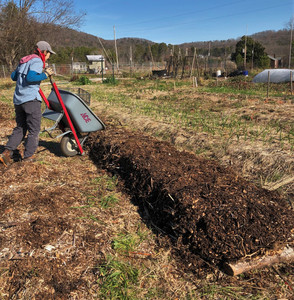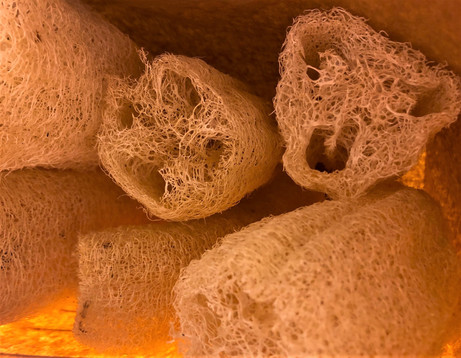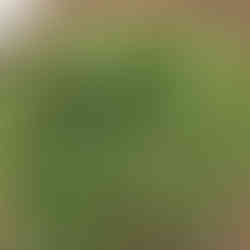December 2019
- Rosa
- Dec 31, 2019
- 5 min read

Chicken Time
After weeks of molting and (surprisingly mild) winter weather, the chickens are more eager than ever for treats. They regularly receive pumpkins, grains, and grubs, but in the winter, they seem more eager than usual for fruit and vegetables (which is also how I feel, honestly.) Lettuce harvests always yield a mound of leaves that aren't quiet good enough for people but are gourmet for the hens. They also enjoyed the fast food fruit medley I brought them, though they squabbled over who got the strawberries.
We decided to transition the coop bedding from from pine chips to hay. Now that we have an actual compost system, we can properly use the valuable resource of chicken manure. Chicken manure is high in vital nitrogen, but it cannot be placed directly into the soil without first being composted. Cedar chips take a while to decompose, so hay is a better material for incorporating the manure into the compost.
Cleaning the current bedding out of the coops was the first step. The chips absorb most of the smell and keep everything dry, so the main drawback of the job is the dust. I wore a bandanna around my face as I filled up wheelbarrow after wheelbarrow of bedding. A few chickens kept me company, scratching along behind me.
When I was done, Lilly took over. She lay down fresh hay on the floor and re-filled the nesting boxes. The coops smelled sweet and dry after we were done. The chickens had a nice time all around, especially when they got to pick through the incoming hay. We'll lay down another layer of hay in a week or two, and keep adding like that for a few months. Then we'll clean out the deep hay and move it into the compost, and start the process over.
Hugelkultur
While I was removing the chicken bedding, Lilly was building a new garden bed. The bed uses a technique called hugelkultur, which is a German word which roughly means "mound culture." Essentially, garden beds are constructed using wood, plant materials and limited soil. There's many ways to do it, but this first bed is an experiment using the material we had available.
The first layer was the old stems of okra, hibiscus, and other plants. They are too large to go into the compost system, but perfect for a mound. Next, I brought in my shipments of pine bedding from the coop. The chicken manure will provide much needed nitrogen to the decaying material, and the slow process of the hugelkultur mound will give the chips time to break down.
The final layer was the mulch that has been suppressing the grass along the border of the garden. This mulch is several months old, and in parts nearly decayed to soil. We surrounded the bed with wood and branches, and the sealed the edges with more mulch.
Some of the stems and plant material that went into the bed came from our temporary compost cylinders that we used over the summer. After emptying them, Lilly found a layer of rich soil at the bottom, and inside that, a handful of sprouting potatoes. The tenacious spuds had escaped last summer's harvest and weathered the heat and cold in their insulating compost.
The potatoes had clearly proved themselves, so they got to be the first inhabitants of the new mound. Although hugelkultur beds take a few seasons to break down into a more soil-like bed, plants can grown in them as long as there is some soil or mulch to start in. In fact, plants can help the soil develop, and they benefit from the water retention capacity of the mound. So we planted the potatoes inside pockets of their compost inside the mound. If all goes well, they will survive to spring and yield a little harvest in the summer.
Second Seedlings
Many of the seeds we sowed indoors weeks ago grew large enough to transplant out into the beds. On a cool, wet day, we brought out the trays of feverfew (in the Daisy family) and Sweet William (in the Carnation family). We separated out the soil blocks and planted them into the spaces left from the fall seeds which never germinated. It's an unusual time to plant flowers, but weeks indoors hopefully provided them with a useful head-start.
The outdoor plants that did germinate are doing well, especially the bachelor buttons (Centaurea cyanus). Their long leaves are covered in silky hair, and they hold rain water like little gems. The Ranunculus, too, are flourishing, which I am especially glad about. This is our first time ever growing this colorful, many-petaled perennial, and their blooms seem wonderful.
Under the growing lights, some of the slower growers required a couple more weeks to get big, but eventually got their turn. The black-eyed Susans, with their bristly spoon-shaped leaves, took their place in the garden and settled in beneath the covers to continue growing at the pace of unconscious snails.
We've re-made our flower garden plan and new seeds are on their way. As they arrive, we'll start many more little plants inside and fill out our flower garden. The mild winter is helping ease along our trial-and-error process of starting cold-weather flowers. Though it was hard to lose so many seeds in the fall, I'm hopeful that by spring our garden will be bursting with blooms.
Final Luffas
Our luffas have at last dried enough to be peeled. When they are ready, their skin feels loose to the touch, dry but not desiccated. We cut both ends off and then tear a seam down the length of the gourd. Then, the skin can be peeled off quite easily, leaving behind the inner framework fiber. (It's as satisfying as it sounds). The sponge gets rinsed and set out to dry. In a few days, it becomes dry but not brittle. The loose seeds can be tapped out, and then the luffa is ready to be used as a sponge for dishes, cleaning, or exfoliation.
Around the Garden
In-between our big projects, the ongoing preparations for spring carry on. We lay leaves down on the newest beds, covering them with row covers to protect them from the high winds which often tear across our hilltop. We rake mulch into pathways and tractor in new soil for beds. Our cat helps by sitting on different surfaces and meowing occasionally.
We trimmed the leaves of a comfrey and added them to the compost. They decompose well and contain high concentrations of useful nutrients. We've been adding grass, leaves, and food scraps to the compost, but very soon we'll stop and let it rest for a few months, making sure to turn it regularly, especially when it's as rainy as it has been lately.
The cover crop of clover is flourishing, nearly a foot tall now. It's only on two beds, but it's success is encouraging. In the future, we'll strive to cover crop as many beds as we can. In a bucket of water, our next set of elderberries is rooting. They'll grow slowly in the cold, but so far their root nibs and tiny emerald leaves bode well. The cold has burnished the strawberries burgundy and gold. They rest in the winter, so the babies we planted are still little, but still alive.
I hacked into the coolest-looking pumpkins we got from autumn decoration donations, and dried batches of their seeds. I put them into envelopes, labeled them, and stored them with the rest of our seeds. They'll go into mounds alongside our vegetable garden in the spring, and hopefully produce an array of gourds next fall.































































































Comments